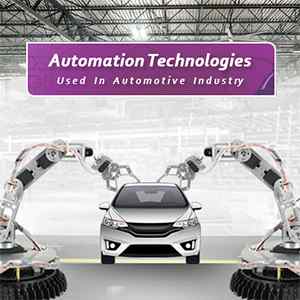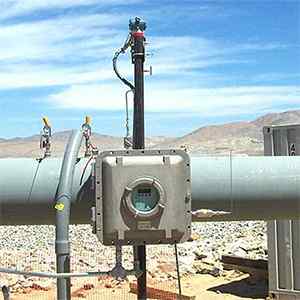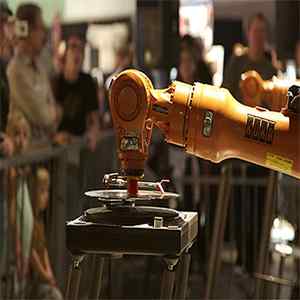Articles
Top 4 Automation Technologies Used In Automotive Industry

Introduction
Industrial automation is pervading most industries these days. It wouldn’t be surprising if much of the industrial intelligentsia have already begun looking into the prospects of precision agriculture, smart manufacturing, or digital medicine. And these industries, including automotive, aren’t novice to automation technologies such as Artificial Intelligence (AI) or machine learning.
The recent deterring speech by automotive titan Tesla CEO Elon Musk on the use of level-5 AI and robotics in automobiles made one thing clear: the stellar leaps in current automation and robotics are indeed causing shockwaves and beaming our industries into the future, which may usher in a new industrial revolution. Of course, any claim of Skynet metamorphosing into reality or robots taking over all our jobs can be considered a hyperbole at this point.
Delving into the positive outcomes of current advancements while anchoring one foot to reality, however, is essential to preventing any cataclysm that may ensue from the marriage of automation to automobiles, such as a world war between competing nations. Collaborative robots, robotic arms and the Internet of Things coupled with AI are already producing a large part of the automobile chassis, power trains and other components in some companies, save a few simpler parts that can be made by human workers.
Now pervading the automotive industry, robots are handling even the most complex manufacturing tasks, and completing them several times faster than human workers. Advanced robotics, combined with automation technologies and learning modules, are performing jobs with more precision than ever and increasing industrial productivity. Although much of robotics technology such as AI or IoT is in its infancy, it is still a colossal leap from what our industries had until the late 1980s. It is barely possible to tabulate an exhaustive list of all the intriguing marvels erupting from the most brilliant, industrious minds in the industry.
Here are the four most advanced automation technologies used in the automotive industry:
- Machine Vision
- Collaborative Robots
- Artificial Intelligence for Driverless/Autonomous Cars
- Cognitive Computing in IoT Connected Cars
Machine Vision
The need for safer, more reliable and robust automobiles to justify price points is pushing automakers to adopt machine inspection. And Machine Vision (MV) helps them fulfill this need by providing an automated internal machine inspection method.
And Automotive was one of the earliest industries to have adopted MV to carry out its imaging-based automatic inspection and analysis for automatic inspection, process control, and robot guidance. Also termed “computer vision,” MV is a mother lode of a large number of high-end technologies, software and hardware products, integrated systems, and of course, expertise.
This technology works as the eye of the automotive production process using imaging processes including conventional imaging, hyperspectral imaging, infrared imaging, line scan imaging, 3D imaging of surfaces, and X-ray imaging.
Smart camera or smart sensors with frame grabbers are used along with interfaces such as Camera Link or CoaXPress (or custom interface) to record or capture images of the surface to be inspected. Digital cameras capable of direct connections to a computer via FireWire, USB or Gigabit Ethernet interfaces are also used by several companies.
These cameras capture images of the surface of the automobile component to be inspected (say, the body or fins of an engine). And these images are then analysed and processed by specialized analysis software, which mostly use the principle of Finite Element Analysis in their working. MV helps automakers save money, justify price points and emerge as strong competitors.
National Instruments, Microscans Cognex, Datalogic, Optotune and ViDi Systems are some of the topmost companies whose machine vision systems are preferred by large carmakers.
Collaborative Robots
Generally called Cobots, these are often confused with robots that collaborate with humans. While that is partially true, Cobots are robots that work independently without humans invading their workspace.
A cobot uses machine learning to pause all its operations when a human worker enters its space.
So why are they called Collaborative despite their functions being the contrary? Cobots actually help human technicians by handling a large part of the job. When a certain job requires multiple functions to be done at once, the cobot will allow the labourer to work on it and later shut down once the latter’s job is done. However, not all Cobots are made equally. Some are designed to stop while others are not.
As per ISO 10218, there are four types of Cobots base on functionalities – Safety Monitored Stop, Hand Guiding, Speed & Separation Monitoring, and Power & Force Limiting robots.
Universal Robots, Rethink Robotics, KUKA, ABB Yumi, F&P Robotics and Fanuc are some of the large companies that design, produce and supply Cobots. KUKA and Universal Robots are currently being supplied to automotive companies such as Tesla to build cars, car-building robots, and also assembly lines. Using Cobots in such settings can put carmakers light-years ahead in the race for speed and productivity in manufacturing.
Artificial Intelligence for Driverless/Autonomous Cars
Artificial Intelligence system is defined as, “any system that perceives its environment and takes actions that maximize its chance of success at some goal.” And this is true for the on-research driverless or autonomous or self-driving cars that are using various levels of artificial intelligence. Circling back to Elon Musk, the dreadnought’s Tesla has developed its own driverless car hardware called Autopilot that are currently being used on all Tesla models. And ironically, Musk, as per reports, wants Level 5 automation in all Tesla models.
Artificial intelligence in cars works by first creating and storing an internal map of the surroundings (street, locality or region) using smart sensors such as radar, sonar and/or laser.
It then processes these inputs, plots the most plausible trajectory, and sends instructions to the vehicle’s actuators which control acceleration, braking, and steering. Coded driving protocols, obstacle avoidance algorithms, predictive modeling, and smart object discrimination (i.e., knowing the difference between a bicycle and a motorcycle) help the car follow traffic rules and navigate past obstacles.
Major players such as NVIDIA and Bosch are playing a major role in developing and improving Deep Learning or Machine Learning to improve AI.
Cognitive Computing in IoT Connected Cars
Cognitive Computing (CC) are technology platforms based on artificial intelligence and signal processing. These platforms encompass and use machine learning, reasoning, human language processing, speech and object, human–computer interaction, dialog and narrative generation, among others.
While connected cars are vehicles that use the internet to connect and communicated with one another to build a safe, easy, non-intervening traffic. Some companies such as IBM (Watson AI) and BMW are combining CC and IoT to invent autonomous cars that communicate with each other while recognizing and linking driving patterns to the emotional response of their human drivers during all possible scenarios (such as to applying brakes a moment before collision to avoid accidents).
These would prove to be way more advanced than driverless cars if the technology is successfully tested and replicated. An example of IoT platform is ThingWorx, on which automakers can develop a cloud-based service for connecting to remote OBDII devices and vehicles, manage the vehicle diagnostic and driving behavior data, integrate the data with enterprise systems, and develop new innovative connected-vehicle applications.
A combination of these cross-platforms may someday be able to entirely eliminate accidents and save lives.
Conclusion
These top 4 automation technologies used in the automotive industry among others are ushering in a new renaissance with robotics and artificial intelligence at its heart.
However, the fears expressed by the likes of Musk, Stephen Hawking, Bill Gates and several other technocrats and scientists cannot be allayed as they are valid, if not entirely hyperbolic.
The way ahead must be paved with responsibility and heavy regulations that will enable a safe, easier future that will enable human beings instead of depriving them of opportunities or degrading into wars and sufferings.







